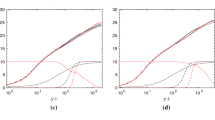Abstract
A statistical method for simulating a boundary layer transition flow is proposed as based on experimental data on the kinematics and dynamics of turbulent spots (Emmons spots) on a flat plate placed in an incompressible fluid. The method determines intermittency with allowance for overlapping spots, which makes it possible to determine the forces on the plate surface and the flow field near the transition region if the mean streamwise velocity field in a developed turbulent boundary layer is known as a function of the Reynolds number. In contrast to multiparameter transition models, this approach avoids the use of nonphysical parameter values.
Similar content being viewed by others
References
I. M. Sobol’, Monte Carlo Method (Nauka, Moscow, 1978) [in Russian].
S. M. Ermakov and G. A. Mikhailov, Statistical Simulation (Nauka, Moscow, 1982) [in Russian].
O. M. Belotserkovskii, S. A. Ivanov, and V. E. Yanitskii, “Direct Stochastic Simulation of Some Problems in Turbulence Theory,” Zh. Vychisl. Mat. Mat. Fiz. 38, 489–503 (1998) [Comput. Math. Math. Phys. 38, 474–487 (1998)].
H. W. Emmons, “The Laminar-Turbulent Transition in a Boundary Layer 1,” J. Aeronaut. Sci. 18, 490–498 (1951).
Yu. I. Khlopkov, V. A. Zharov, and S. L. Gorelov, Coherent Structures in a Turbulent Boundary Layer (MFTI, Moscow, 2002) [in Russian].
A. V. Boiko, G. R. Grek, A. V. Dovgal’, and V. V. Kozlov, Physical Mechanisms of the Transition to Turbulence in Open Flows (Moscow) [in Russian].
T. P. Chong and S. Zhong, “On the Three-Dimensional Structure of Turbulent Spots,” J. Turbomachinery 127, 545–551 (2005).
H. Schlichting, Boundary Layer Theory (McGraw-Hill, New York, 1968; Nauka, Moscow, 1969).
R. Rubinstein and M. Choudhari, “Statistical Prediction of Laminar-Turbulent Transition,” Hampton, Virginia. NASA/CR-2000-210638 ICASE Rep. No. 2000-50.
I. G. Dodonov, V. A. Zharov, and Yu. I. Khlopkov, “Localized Coherent Structures in the Boundary Layer,” Prikl. Mekh. Tekh. Fiz. 41(6), 60–67.
V. A. Zharov, “Diskret Fourier Transform as Applied to the Study of Wave Packet Dynamics,” Prikl. Mekh. Tekh. Fiz. 45(6), 31–37.
V. A. Zharov, Phenomenological Analysis of the Interaction of the Outer Turbulent Flow with a Plane Turbulent Boundary Layer (TsAGI, Moscow, 1993) [in Russian].
Mathematica 5.0: Users Guide (Wolfram Research, 2003).
Author information
Authors and Affiliations
Corresponding author
Additional information
Original Russian Text © O.M. Belotserkovskii, V.A. Zharov, Htun Htun, Yu.I. Khlopkov, 2009, published in Zhurnal Vychislitel’noi Matematiki i Matematicheskoi Fiziki, 2009, Vol. 49, No. 5, pp. 923–928.
Rights and permissions
About this article
Cite this article
Belotserkovskii, O.M., Zharov, V.A., Htun, H. et al. Monte Carlo simulation of boundary layer transition. Comput. Math. and Math. Phys. 49, 887–892 (2009). https://doi.org/10.1134/S0965542509050145
Received:
Accepted:
Published:
Issue Date:
DOI: https://doi.org/10.1134/S0965542509050145




